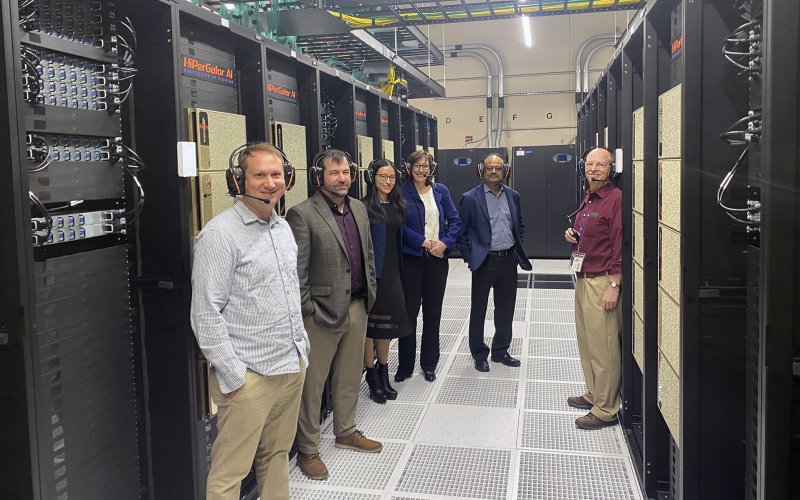Albany AI Design Phase Includes Tour of University of Florida’s HiPerGator

ALBANY, N.Y. (Jan. 26, 2023) — As the design phase of the $200 million, Albany Artificial Intelligence Supercomputing Initiative (Albany AI) gets underway, the University is examining how similar efforts have proceeded at other academic institutions throughout the country.
In January, Vice President for Research and Economic Development Thenkurussi (Kesh) Kesavadas led a delegation from UAlbany to see first-hand how the University of Florida’s (UF) AI efforts are bringing transformational learning opportunities to its students.
Included in the tour was a stop at the university’s HiPerGator complex, the computing power behind UF’s artificial intelligence initiative.
“As we work to bring Albany AI online, we’re actively gathering data and learning about the challenges and successes of other pioneers in the artificial intelligence realm,” said Kesavadas. “We were delighted to be welcomed by the University of Florida and Provost Joe Glover, who has provided innovative leadership in bringing AI to the forefront of the UF learning experience. During the visit, UF VPR David Norton and CIO Elias Eldayrie, along with their AI experts, also offered critical insights about how to best leverage a supercomputing cluster in an R1 university.”
UF’s AI efforts are the centerpiece of a major, long-term initiative that is combining world-class research infrastructure, cutting-edge research, and a transformational approach to curriculum. Among its goals are to expand AI research and development and make sure every UF student develops a basic competency in AI — no matter the major.
The visit follows UAlbany’s launch of a strategic cluster hire of 27 new faculty with a focus on AI in multiple disciplines, including public health, engineering, education, business, homeland security, STEM, and political science among others.
“It is great to learn that our peers in higher education shared the same vision with UAlbany when comes to training the next generation of students in all majors,” said UAlbany Christine K. Wagner, Associate Vice Provost for Faculty Development, “With Albany’s HHMI grant, we are uniquely positioned to collaborate with industry to diversify the future of the AI-savvy workforce. UF’s experience in AI across the curriculum and their AI cluster hire is invaluable for us as UAlbany is actively recruiting 27 new faculty across all colleges and schools, with the earliest cohort coming in Fall 2023.”
The computing power behind AI endeavor is HiPerGator, a cluster that includes the latest generation of processors and offers nodes for memory-intensive computation. HiPerGator’s high-performance storage systems can be accessed from diverse interfaces, including Globus, UFApps for Research, and other tools. The latest generation, HiPerGator AI, 140 NVIDIA DGX A100 nodes, 17,920 AMD Rome cores, 1,120 NVIDIA Ampere A100 GPUs, 2.5 PB all-flash storage, more than 200 HDR InfiniBand and various Ethernet switches for connectivity, double precision LinPack (HPL) at 17.2 Petaflops, and AI floating point operations at a rate of 0.7 Exaflop (.7 quintillion / 700 quadrillion) per second.
Located in UAlbany's Uptown Data Center, the Albany AI supercomputer will make computing clusters and exploratory hardware with the latest chip designs available to government, industry, and university scientists across New York. The cluster will provide high-speed computational power to test, train and deploy next-generation AI algorithms and machine learning systems and employ cutting-edge exploratory hardware with the latest in chip designs. This will help dramatically expand UAlbany’s AI research footprint and help drive discoveries in engineering, atmospheric and climate sciences, blockchain, health equity and data analytics, homeland security and computational genomics — and support innovative creative activity in the arts and humanities.
“In this design phase, UAlbany has adopted a multipronged approach. We’re rapidly building up AI computational resources and support staffing in preparation for the AI faculty cluster hires this year,” said UAlbany Chief Information Officer Brian Heaton. “We’re also designing phase 1 of the AI supercomputer that will take advantage of the data center's current power and cooling capacity, while concurrently planning for a data center capacity uplift that will enable phase 2 of the AI supercomputer.”
This work will build on UAlbany's existing research strengths, including collaborations like the recently announced partnership with IBM Research using AI to study water quality, weather prediction and renewable energy forecasting; the new Virtual Institute for Cyber Operations Research established in partnership with Florida International University and the Griffiss Institute; and a $20 million AI institute funded by the National Science Foundation in which UAlbany’s Atmospheric Sciences Research Center is a key partner.
In the meantime, Albany AI will continue to build its academic footprint following similar models as those employed by the University of Florida, which has launched an undergraduate certificate in AI Fundamentals and Applications.




